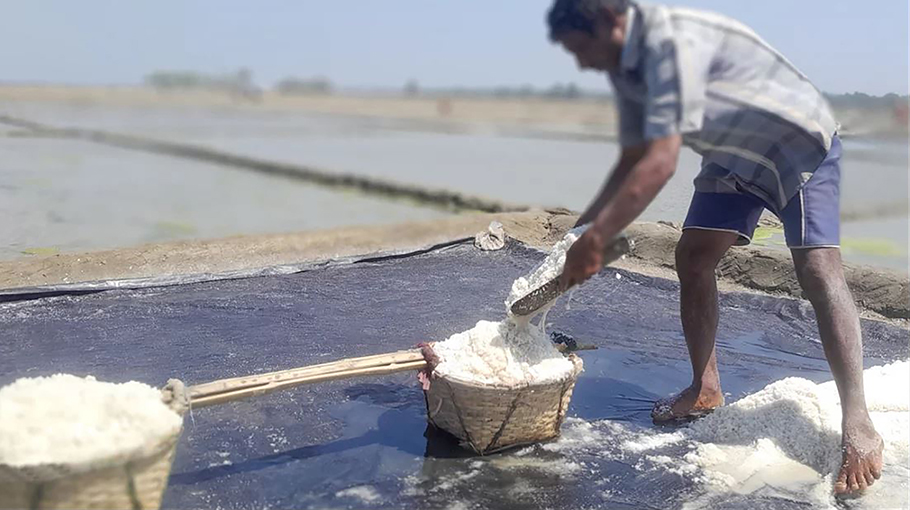Salt production begins in Cox’s Bazar

Salt production this season has begun in Kutubida and Pekua upazilas of Cox’s Bazar and Banshkhali upazila of Chattogram from the first week of November.
The target for salt production in 2024-25 season is 26.1 lakh metric tonnes. By Friday, approximately 220 metric tons of salt had been produced in Kutubdia, Pekua, and Banshkhali upazilas.
According to Bangladesh Small and Cottage Industries Corporation (BSCIC), salt cultivation for this season will take place on 69,000 acres of land in Teknaf, Cox’s Bazar sadar, Kutubdia, Moheshkhali, Chakaria, Pekua, Eidgaon, and Banshkhali upazilas between November 15 and April 15. The target for salt production is set at 26.1 lakh metric tonnes this year, compared to the 24.38 lakh metric tonnes produced last year on 68,505 acres of land, which was a record high in the 62-year history of commercial salt production. If temperatures remain high and there are no storms or rain, production may surpass the target. The annual demand for salt in the country has been estimated at 25.5 lakh metric tonnes.
This season, preparations are underway for salt cultivation on 7,000 acres in Kutubdia, 4,421 acres in Teknaf, 15,000 acres in Moheshkhali, 10,000 acres in Pekua, 11,000 acres in Chakaria, 5,000 acres in Eidgaon’s Pokkhali, 3,900 acres in Cox’s Bazar Sadar, 7,000 acres in Banshkhali, and 1,850 acres in Patiya.
According to BSCIC, salt production was carried out using modern polythene technology on over 68,000 acres last year. This year, the same technology will be applied across 100 percent of the cultivation area, with farmers having received the necessary training. Salt production with polythene technology yields 2.5 times more than the traditional method. Around 44,000 marginal farmers, one lakh laborers, and at least 10 lakh people are involved in salt production, marketing, transportation, and related businesses.
Mohammad Idris Ali, a field inspector for the BSCIC Salt Development Project, said that stakeholders are very pleased with the early start in this season. Since Kutubdia does not have shrimp farms, 70 percent of the land there is already being cultivated and producing salt ahead of the formal season. Similarly, 50 percent of the fields in Chhanua of Banshkhali and 70 percent in Pekua have started salt production. Other farmers are also preparing their fields, and it is expected that by early December, all fields will be under cultivation.
He added that despite the early start, the current market price for salt is between Tk 340 to Tk 350 per maund, while production costs range from Tk 360 to Tk 370 per maund, resulting in a Tk 20 loss per maund. Farmers could see a profit if prices were between Tk 400 to Tk 450 per maund. However, the current low prices have left farmers frustrated. If financial losses persist, the area under cultivation may shrink, potentially disrupting the production target. Investigations are underway to determine the reason for the price drop.
Sona Mia, a 53-year-old salt farmer from Uttar Dhurung Kalamiyapara in Kutubdia, shared that last year he cultivated 5 acres of land and sold salt at Tk 400 to Tk 500 per maund throughout the season. This year, he has expanded salt cultivation to 6 acres but is facing losses as prices have fallen to Tk 330 to Tk 350 per maund at the start of the season, while production costs remain around Tk 360 to Tk 370 per maund.
Another farmer, Ehsan Amin, said that last season’s prices of Tk 400 to Tk 500 per maund motivated farmers to begin production early this year, hoping for similar profits. However, the initial losses have been disheartening. Despite the low field price of Tk 10 per kg, packaged salt is sold for Tk 35 to Tk 40 per kg in retail markets, with no oversight to address this discrepancy.
Zafar Iqbal Bhuiyan, Deputy General Manager of the BSCIC Salt Industry Development Project Office in Cox’s Bazar, said that farmers began work 15 days earlier this season. With production already underway in Kutubdia, Pekua, and Banshkhali, they are optimistic about achieving another record-breaking season. Full-scale production across all fields is expected by mid-December and will continue for five months. Last March, a record 45,000 metric tons of salt was produced daily. However, rain can halt production for 5-7 days at a time. Efforts are ongoing to ensure farmers receive fair prices for their salt, he added.




